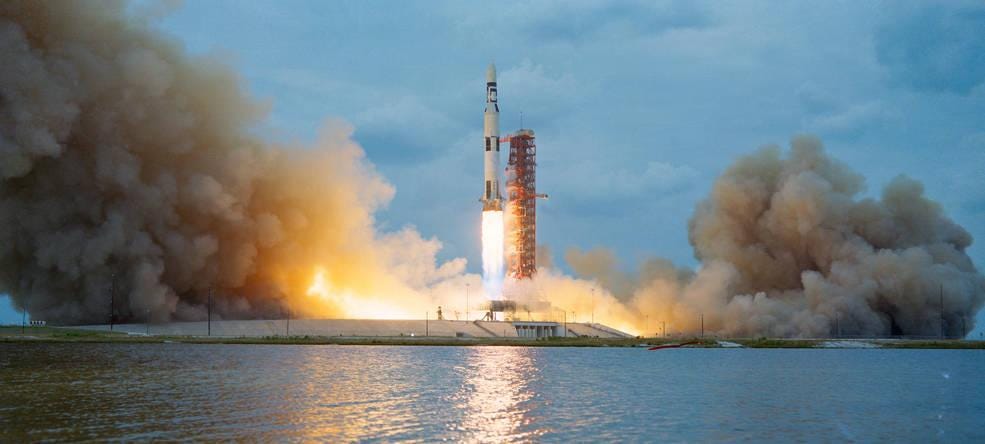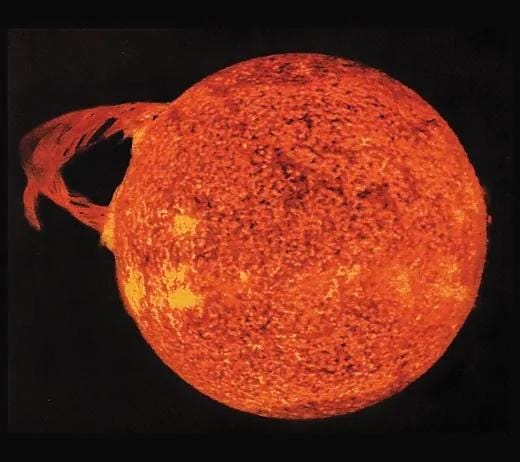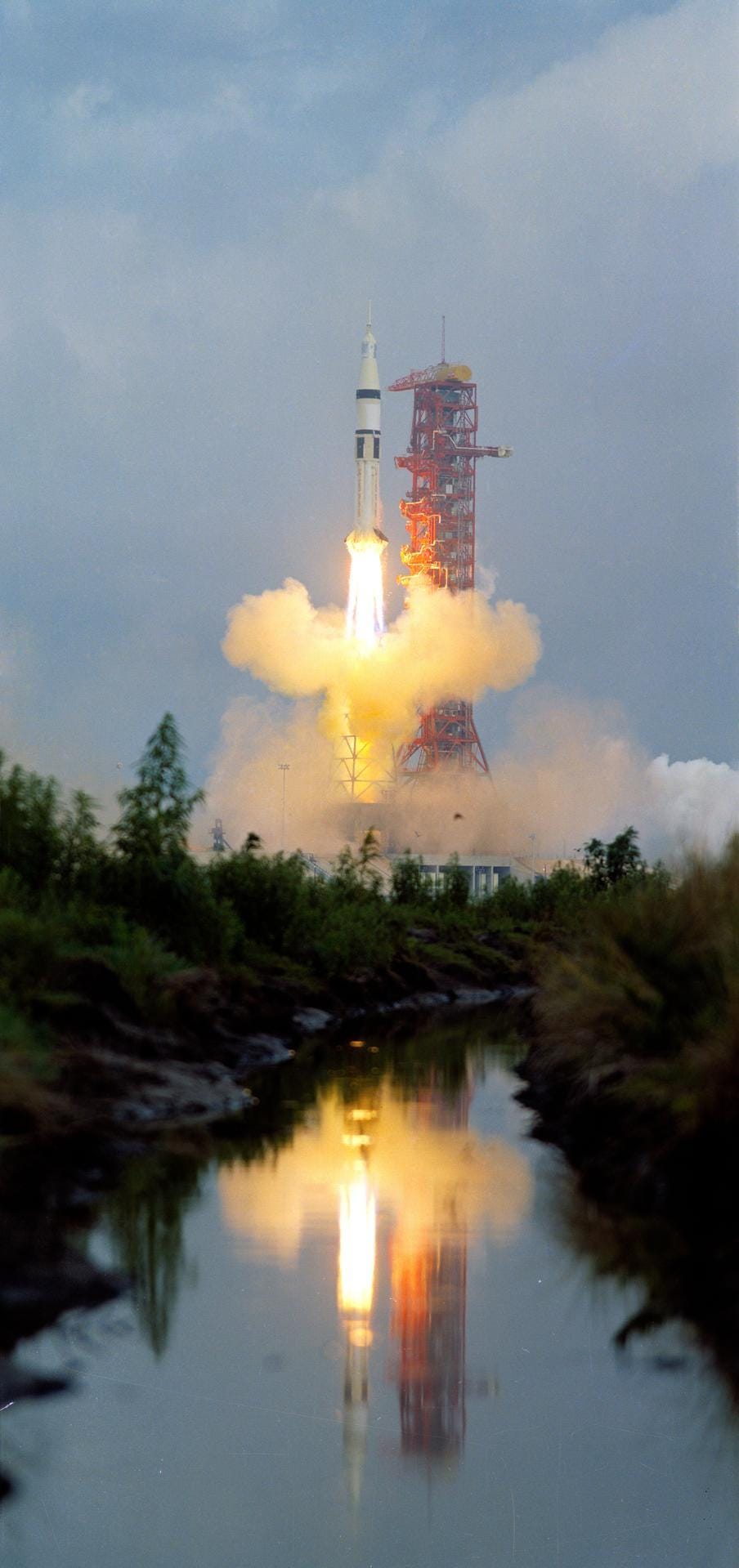A Space Station on the Cheap
The creation, launch, records broken and demise: A brief story of Skylab
This week the 52nd anniversary of the Skylab I mission of May 14, 1973, was observed. Skylab is now largely forgotten, but if it is remembered, it is for its inauspicious beginnings of arriving in orbit damaged, leaving it low on power and its interior dangerously hot for a manned crew. It is also remembered for its early and unexpected demise due to unplanned solar activity decaying its orbit and increasing atmospheric drag, causing early re-entry to Earth on July 11, 1979, with debris landing in the Indian Ocean and western Australia. Despite the beginning and end of Skylab, it was actually an early pioneer of the space race and the continuation of the manned space and Apollo programs after the completion of the lunar missions. The lessons and technology of Skylab were to be used in future programs such as the Space Shuttle and the International Space Station.
Skylab 1 launch May 1973 (picture from NASA)
Skylab was not originally planned but was a by-product of what was called the Apollo Applications Project. The Apollo Applications Project, known as the AAP, was created in 1966 by NASA with the goal of using the hardware that was developed for Project Apollo. The AAP was created out of a decision that NASA had to consider in 1965. Though the lunar landing did not happen until 1969, there was already an anticipation that budget cuts to the program would occur after a successful landing and return from the Moon. NASA leadership anticipated two possibilities when it created the AAP. The first was that budget cuts would be significant and no new Apollo hardware would be ordered after the completion of the lunar missions. In 1965, it was anticipated that the Apollo program would need the equipment and support for 21 Saturn 1B launches and 15 Saturn V launches by the end of 1973. The AAP in this scenario was strictly based on unused surpluses from the Apollo Moon missions. This scaled-down version of the AAP would be based around long-duration human presence in space through the creation of a space station in Earth orbit.
The second option that NASA considered was that the Apollo – Saturn hardware would be funded beyond the initial lunar missions and could have NASA pushing the limits of the hardware. This option anticipated supporting extended lunar missions and establishing bases on the Moon, initially aiming for 14-day stays and eventually expanding to a new type of base capable of supporting 200-day stays. This would in turn be expanded in future missions to support a permanent manned presence on the Moon. The program also had a goal of mapping the Moon in an Apollo 8-style flight but with only two astronauts conducting a 28-orbital Moon mission (no landing). One of the most ambitious goals of this option was a manned flyby of Venus that included the creation of using an expended fuel tank as a “wet” workshop using the expended fuel tank of the third stage of the Saturn V.
The expanded option would require a budget of $450 million in FY 1966 and $1 billion in FY 1968. President Lyndon Johnson, however, did not want to support the expanded option and placed a requirement that NASA needed to stay under its current budget of $100 billion, and this led to a decision that the AAP would only be allocated $80 million in FY 1967 for its first full-year budget. The fire aboard Apollo 1 during a test in January 1967 that killed 3 astronauts and the resulting investigation and hearings, though not cancelling the program, cemented in Congress that NASA’s budget would be cut after the budgeted Moon missions. The result was the ambitious second option of the AAP was never going to happen, so NASA had only the modest first option with any surplus Apollo-Saturn hardware that was not used for what were eventually six Moon landings (and one abortive Moon mission of Apollo 13).
The result of the budget cuts was that the primary creation of the reduced AAP program was the Skylab program. Space exploration was still in its early phases, and there were still many unknowns that both the U.S. and the U.S.S.R. needed to explore. The first was that NASA needed to explore aspects of long-duration space flight. NASA, while preparing for the Moon missions, assumed a mission profile for a flight to, landing on, and returning from the Moon would take 14 days. The first attempt at this goal was during Gemini 7 in December 1965, when astronauts Frank Borman and Jim Lovell conducted a 14-day flight in their two-man capsule. The longest Apollo mission was Apollo 17, with a 12-day mission. This was the limit of NASA’s experience of long-duration flight.
Gemini VII December 15, 1965 as seen from Gemini VI (picture from NASA)
Skylab had an objective to allow NASA to test human endurance and its impact beyond the initial 14 days envisioned for the Moon missions. Skylab would also allow the testing of humans working in space over a long period of time. The Gemini capsule had 90 square feet (8.4 square meters) of space, the Apollo capsule has 210 square feet (19.5 square meters), and the Lunar Module 209 square feet (19.4 square meters), so they offered little space for working and running experiments. Skylab was to repurpose the third-stage fuel tank (officially called the S-IVB) of a Saturn V rocket, which had 2,290 square feet (212.7 square meters) with a length of 59 feet (18.0 meters) and a diameter of 21 feet 8 inches (6.6 meters) and would offer considerably more space for astronauts to work and live in than any other accommodation offered in any other NASA space-rated facility to that point in time.
Artist conception of Skylab (picture from NASA)
Skylab would be a “dry workshop” since the Saturn V rocket, which would launch Skylab, would not need the fuel or propulsion of the third stage to reach orbit with Skylab. This is unlike the original space workshop envisioned by the second option of the AAP of using the third stage, after the fuel was expended and then vented, as a workshop, which was dubbed the “wet workshop”. Skylab introduced several innovations, such as the use of an airlock to allow EVAs (space walks) without venting the entire station of its atmosphere (something that was done for all EVAs in Gemini and Apollo). Skylab had an Apollo Telescope Mount (ATM) in addition to its other scientific experiments on each manned mission.
The ATM was a solar observation instrument on Skylab and was probably the most iconic part of Skylab. The ATM was atop the space station and had four solar panels extending on each side. The astronauts would need to replace the film canisters in the ATM during their EVAs. The instrument would take pictures of solar activity through visible light, ultraviolet light, and X-Rays. At the conclusion of the mission, the crew brought the recovered film canisters back to Earth for development. The ATM was not the first space telescope, the Soviets were first in 1971 with their Salyut 1 space station, but it was the first U.S. one and one that scientists in the U.S. would have access to the results of the ATM data and pictures.
ATM (picture from the National Air and Space Museum)
Solar flare picture from Skylab 1973 (Picture from NASA to Smithsonian Magazine)
NASA decided to develop Skylab and an initial plan for three manned missions to the station in 1973. The launch schedule was for one Saturn V to launch the Skylab station into orbit, followed by four missions with three astronauts each using the Apollo spacecraft launched on a Saturn 1B booster, just as the first manned Apollo mission used for Apollo 7. The missions laid out were the following:
Skylab 1: May 14, 1973
• Unmanned
Skylab 2: May 25, 1973 (originally scheduled for May 15, 1973)
• Charles “Pete” Conrad Jr. – Commander
• Joseph Kerwin – Science Pilot
• Paul Weitz - Pilot
Skylab 3: July 28, 1973
• Alan L. Bean – Commander
• Owen Garriott – Science Pilot
• Jack R. Lousma - Pilot
Skylab 4: November 16, 1973
• Gerald R. Carr – Commander
• Edward G. Gibson – Science Pilot
• William R. Pogue - Pilot
Skylab 5: Cancelled
• Vance R. Brand – Commander
• William B. Lenoir – Science Pilot
• Don Lind - Pilot
There was also a standby Skylab rescue mission that was never utilized.
Skylab 1 was launched on May 14, 1973, with just the space station atop a Saturn V rocket. Shortly after launch, the meteorite shield on the space station was torn off, and with it one of the two solar panels that provided the station with electrical power, and damaged the other shield that prevented it from fully deploying. This left the station critically low on electrical power, and due to the loss of the shield, the interior of the space station reached 130 degrees Fahrenheit (52 Celsius). Initially Skylab 2 was to be launched the following day, but due to the damage was delayed for 10 days to allow NASA to work out procedures to repair the remaining solar panel and reduce the interior temperature inside Skylab.
Skylab 2 was launched on May 25, 1973, with new equipment and procedures to fix Skylab. The crew was able to fix the remaining solar panel and allowed it to deploy to restore power to the station. A 24-foot by 22-foot parasol made of an aluminum and Mylar material was attached to the station over the area of the missing meteorite shield. The result was the temperature in the station was brought down 98 degrees Fahrenheit (37 Celsius) and made it at least livable for the Skylab 2 (and future crews) to live on the station. The Skylab 2 crew was able to achieve not only the repairs but also a record 28-day mission to space, doubling the achievements of Gemini 7.
Skylab 2 launch May 25, 1973 atop a Saturn 1B rocket
The Skylab 3 and Skylab 4 missions were also launched in 1973, and each broke space endurance records, with the Skylab 3 mission lasting 59 days and the Skylab 4 mission lasting 84 days, as both set endurance records for the time. Skylab 4 ended on February 8, 1974, as it represented the closing of the Apollo-Saturn program and an era of the American space race-winning program. The closing act of the program and the AAP occurred in July 1975 with the joint Apollo-Soyuz program with the rendezvous and docking of the two space rivals in Earth orbit and marked the unofficial end of the space race. NASA went on to unmanned exploration and the development and launch of the Space Shuttle. The Soviets continued with their own unmanned exploration program (led by Venera) and their own space stations, but the Apollo program and the rivalry ended in 1975 as both countries pursued their own goals in low earth orbit.
Skylab was the only exclusively American-built and manned space station. The cancelled Skylab 5 mission was supposed to be a 20-day mission with the primary goal of boosting the station's orbit with the expectation that the future Space Shuttle program would be able to launch to Skylab and once again bring the station to life. Delays in the Space Shuttle program delayed the first launch until April 12, 1981, which turned out to be too late for Skylab. The result of not boosting the orbit and an unexpected atmospheric drag most likely due to increased solar activity caused Skylab to meet an early demise on July 11, 1979, during an uncontrolled re-entry, with space station parts impacting parts of Australia. Project Apollo met an unceremonious end in the southern hemisphere.
Skylab oxygen tank found in Australia 1993 (picture from Reddit)
Rivalry was later replaced by cooperation as the U.S. and Soviet Union, and later Russia, pursued working together in space as the Cold War also ended, and with it the U.S. sent space shuttles and crews to the Soviet-Russian Mir space station, and later both became the main partners in creating and building the International Space Station. The ISS was manned on November 2, 2000, by a Russian-American crew and has been continuously manned for nearly 25 years, and for the U.S., its low Earth orbit, long-duration program of ISS draws its origins from a spare parts option of the Apollo Applications Program.
Research or support me through Patreon, Buy Me A Coffee or Ko-Fi.
References:
https://www.nasa.gov/skylab/
https://apollo11space.com/what-was-the-purpose-of-the-apollo-applications-program/
https://www.smithsonianmag.com/air-space-magazine/top-nasa-photos-of-all-time-9777715/
https://lasco-www.nrl.navy.mil/skylab/index.php#:~:text=SKYLAB%20was%20the%20world's%20first,that%20was%20attached%20to%20SKYLAB.
https://www.nasa.gov/history/50-years-ago-the-launch-of-skylab-americas-first-space-station/#:~:text=On%20May%2014%2C%201973%2C%20the,Skylab%20space%20station%20into%20orbit.
https://www.nasa.gov/gallery/skylab/











